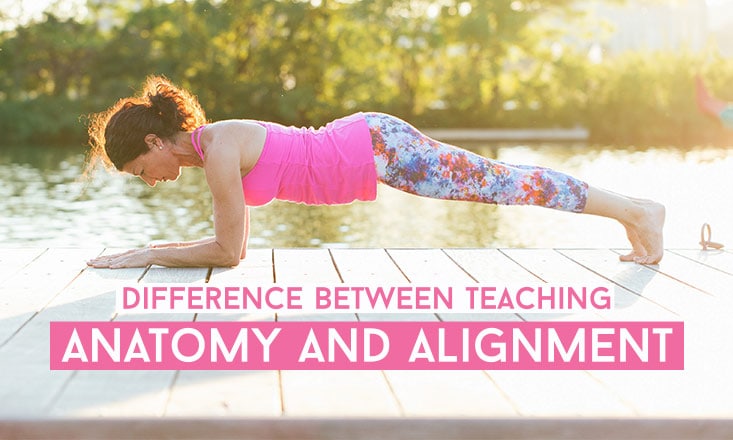When I was taught to teach yoga, I was trained on a number of things. Much of the physical instruction focused on the shape of the poses and the cues to provide.
My impression of the cues and instruction was that it focused on what we would consider “alignment”—that is, how to position the body such that the practitioner is safe, steady and experiencing the benefits of the pose.
As I began to delve into anatomy more and more, primarily in the context of a yoga practice, I began to discern between teaching alignment and teaching from an anatomical perspective. Please know that both are wonderful; this is not to say that one is better or worse than the other.
It’s just interesting to me to begin to explore what happens when we focus on the anatomical perspective of teaching. Here are a few examples:
1. Knee Over the Heel
Alignment: “Stack the knee over the heel”
Anatomy: “Keep the knee over the heel to prevent increased pressure on the patella”
Rationale: Due to convergence of all 4 heads of the quadriceps on the patellar tendon, as the knee moves past the heel, the pressure on the kneecap increases.
2. Interlace Fingers Behind the Back
Alignment: “Interlace the fingers behind the back”
Anatomy: “Interlace the fingers behind the back and squeeze the shoulder blades together”
Rationale: Focus on key action of adducting (drawing together) the shoulder blades rather than interlacing the fingers to emphasize pectoral stretch.
3. Cueing from Plank
Alignment: “Come forward to your tip toes, lower halfway down”
Anatomy: “Come forward to your tip toes, lower halfway down, resist dipping shoulders below elbows to protect rotator cuff”
Rationale: Prevent shearing force on rotator cuff by only lowering half way down before coming into Upward Dog.
4. Coming Into Wheel Pose
Alignment: “Set hands up by your head, elbows in, press down into feet and come up”
Anatomy: “Set hands up by your head, elbows in, press down into feet, keeping feet straight and come up”
Rationale: All other cues aside, mentioning the position of the feet allows students to use the gluteus maximus for the hip extension piece of the posture without using its additional action of external rotation, which compresses the sacrum in backbends.
Finding the Balance in Alignment and Anatomy
As a new teacher and in the years after that, I focused primarily on the alignment. The good news is that learning healthy alignment covers much of what needs to be there from an anatomical perspective.
However, the difference is that when you teach alignment, at least when I did, I wasn’t thinking beyond the shape of the pose as to “why” we would teach the posture in that particular way. For some poses it was obvious. For instance, stacking your shoulder over your wrist in poses like Plank and Side Plank allowed you to be very steady versus if you did not.
But why would we want to keep the feet straight in Wheel? Why would we want to avoid dipping below the elbows in Low Push Up? These were some of the questions I didn’t have, because I was focused on the skin and the shape of the pose, not what was going on underneath.
Know the Why's Behind Your Teachings
When we train new teachers, the more we know as a senior teacher about the “whys” behind what we teach, the more we can share that and give new teachers critical information about the anatomy of the practice.
This allows them to become independent thinkers rather than simply parroting what we suggest. This in turn allows them to answer student questions about the alignment presented with a sense of “why” rather than “well, that’s just how I was taught.”
Think of the things you offer as you teach. Think of those things that you always emphasize and ask yourself, “Why do I teach it that way?” If your answer is, “That’s the way I was taught,” see if you can do a little research to uncover the rationale behind it.
The more you know about anatomy, the more you can start to create your own sequences with sound process.~Karen Fabian
Keep in mind that teaching from an anatomical standpoint is always a balance. You don’t want to overwhelm your students with information and talk their ear off.
Leave space for them to hear their breath and process what they’re doing. Also, keep in mind if teaching with an anatomical focus doesn’t speak to you, don’t use this as the focal point of your instruction in terms of what you say. But know that as you share the poses and the sequence, it’s underlying everything you do.
Most of all, as you teach, always be yourself. This is always the best way to build connection with your students.


